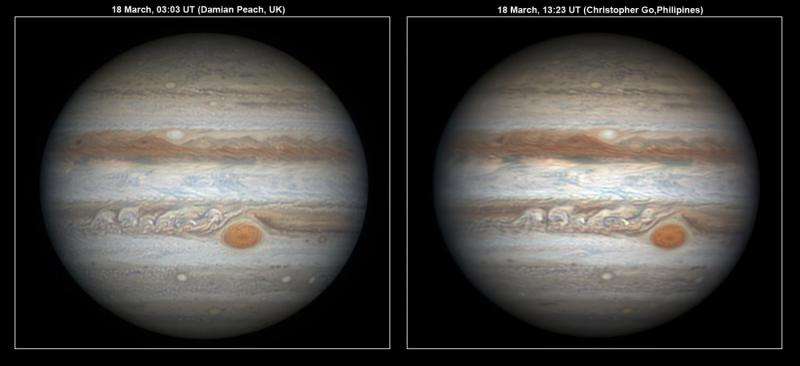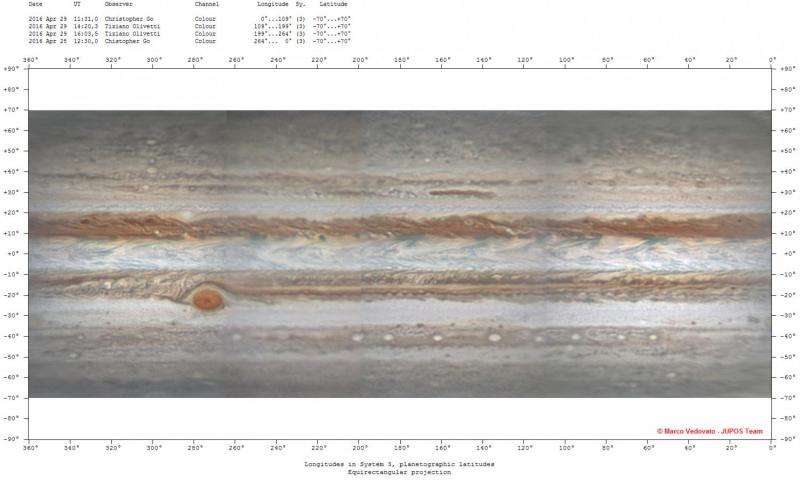Amateurs prepare big-picture perspective to support Juno mission

Some of the world's leading amateur and professional astronomers are meeting on 12-13 May to prepare for a campaign of ground-based global observations in support of NASA's Juno mission to Jupiter. Juno arrives on 4th July this year and will investigate Jupiter through a series of long elliptical orbits with close flybys of the giant planet. To put these observations into perspective and to understand Jupiter's atmospheric dynamics, the Juno project on behalf of NASA has requested the collaboration of amateur astronomers back on Earth. High-resolution observations obtained by amateur astronomers will allow Juno mission scientists to characterise the state and evolution of Jupiter's atmosphere over the course of the mission, which is due to end in February 2018.
A workshop to coordinate ground-based support for Juno from amateurs is being held at the Observatoire de la Côte d'Azur in Nice, France, and organised as part of Europlanet 2020 Research Infrastructure's networking activities. The 29 participants include 13 planetary scientists and 16 amateur astronomers from 13 countries in Europe and around the world, including Romania, Slovenia, USA, Japan and the Philippines.
"The collaborative effort between Juno and amateurs is linked to JunoCam, the mission's visual camera," explained Ricardo Hueso, chair of the workshop's scientific organising committee. "JunoCam, JIRAM and MWR will obtain close up views in the visible, infrared and radio of Jupiter's upper clouds over relatively small areas of the planet, some of them around the size of the atmospheric storms that we see as the oval features in Jupiter's cloud bands. This opens an exciting opportunity for amateurs to provide a unique dataset that will be used to plan the high-resolution observations from JunoCam, and will advance our knowledge of the atmospheric dynamics of Jupiter."
Juno is the first mission dedicated to Jupiter exploration since the Galileo mission in the 1990s. One of its primary goals is to study Jupiter's gravitational field, inner structure and deep atmospheric composition in order to understand the origin and evolution of the planet.

Jupiter has the fastest rotation of any planet in our Solar System, with its day lasting less than 10 hours. Amateur astronomers at different locations around the globe are able to observe Jupiter continuously and monitor how events, such as storms or cloud stripes, evolve through the planet's atmosphere. For nearly a decade, amateur astronomers collaborating from America, Europe and Asia have created high-resolution maps of Jupiter's upper atmosphere, which are updated every few days. Over most of the 20 months of the Juno mission, the amateur contributors will observe the same areas of the planet repeatedly and obtain a long-term global view of changes in the atmosphere, such as the intensity of the winds and the activity of storms in the planet.
Christopher Go, a leading amateur astronomer from the Philippines, said, "I've been imaging Jupiter since 2004 and have worked for many years to develop collaborations between amateur and professional astronomers. Amateurs have the advantage in that they don't have to apply for telescope time, and the equipment now available means that we can make very high-quality observations. I am delighted that the amateur community has been invited to collaborate on Juno and excited at the opportunity to make an important contribution to the mission."
Glenn Orton from JPL, who is responsible for coordinating Juno observations with Earth-based observations of Jupiter's atmosphere, said, "Amateur observations can provide continuous monitoring of the atmosphere, creating a fluid documentation of the evolution of atmospheric features. This is particularly important during the active-mission phase because Juno's remote-sensing observations will cover all latitudes from pole to pole, but they will be confined to narrow strips of longitude, except close to the poles themselves."
Provided by Europlanet





















